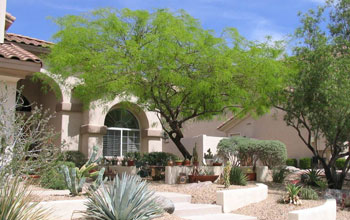I like this
story for two reasons. First, it goes against my pre-conceived ideas
and I always love that. And second, it gives practical suggestions for what
people can do to make their yards friendly to birds. Susannah Lerman of the
University of Massachusetts and her colleagues have found that wild birds can
forage more successfully in yards with native plant life.
Why did
this surprise me? The yards in question were in Phoenix, Arizona. That means
that the researchers compared xeric (desert-like) gardens with mesic (moist, grassy)
gardens. Although it seems obvious that birds would prefer native plants, I
still thought birds would find more food in a lusher landscape. Not so.
Twenty
homeowners volunteered their yards for science. The yards were divided evenly
between mesic and xeric gardens. Two seed trays containing an exact number of
seeds mixed with sand were placed in each yard. Thus, any bird feeding at a
tray would have to spend some time sifting through the sand to pick out the
seeds. At some point, each bird will decide that it’s no longer worth the energy
or risk of predation to keep poring through the seed tray. The more food that’s
available in the vicinity of the seed tray, the sooner birds will abandon it
and forage elsewhere.
Birds stuck
with the seed trays for much longer in mesic than in xeric yards. That is, the
birds were less able to find the food they needed in the lusher yards than in
the desert yards. The grass may be greener on the other side of the fence, but
that’s no enticement to native birds.
Top: A xeric, or desert, yard in Phoenix: This yard with native vegetation is a mini-refuge for birds.
Bottom: A mesic yard in Phoenix, with its non-native grass lawn, is less attractive to native birds.Credit: Susannah Lerman.
These data suggest that any homeowner who wishes to attract birds to his yard consider landscaping it with native plants. Since this also means that the owner will use less water and chemicals to maintain that yard, it’s a win-win for everyone.


No comments:
Post a Comment